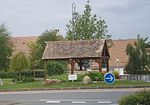Circuit de la Sarthe

The Circuit des 24 Heures du Mans, also known as Circuit de la Sarthe (after the 1906 French Grand Prix triangle circuit) located in Le Mans, Sarthe, France, is a semi-permanent motorsport race course, chiefly known as the venue for the 24 Hours of Le Mans auto race. Comprising private, race-specific sections of track in addition to public roads which remain accessible most of the year, its present configuration is 13.626 km (8.467 mi) long, making it one of the longest circuits in the world. The capacity of the race stadium, where the short Bugatti Circuit is situated, is 100,000. The Musée des 24 Heures du Mans is a motorsport museum located at the main entrance of the venue. Up to 85% of the lap time is spent on full throttle, putting immense stress on engine and drivetrain components. Additionally, the times spent reaching maximum speed also mean tremendous wear on the brakes and suspension as cars must slow from over 322 km/h (200 mph) to around 100 km/h (62 mph) for the sharp corner at the village of Mulsanne.
Excerpt from the Wikipedia article Circuit de la Sarthe (License: CC BY-SA 3.0, Authors, Images).Circuit de la Sarthe
Chemin de l'Ormeau de Vaux aux Hunaudières, Le Mans
Geographical coordinates (GPS) Address Nearby Places Show on map
Geographical coordinates (GPS)
| Latitude | Longitude |
|---|---|
| N 47.937694444444 ° | E 0.22561111111111 ° |
Address
Centre de la Pincenardière
Chemin de l'Ormeau de Vaux aux Hunaudières
72230 Le Mans
Pays de la Loire, France
Open on Google Maps










